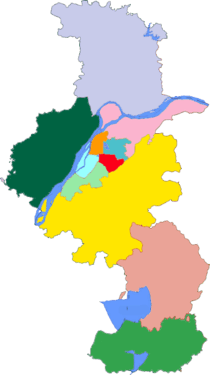Purple Mountain
| Purple Mountain | |
|---|---|
| Zijin Mountain | |
|
View from the Purple Mountain Observatory | |
| Highest point | |
| Elevation | 447 m (1,467 ft) |
| Coordinates | 32°05′N 118°48′E / 32.083°N 118.800°ECoordinates: 32°05′N 118°48′E / 32.083°N 118.800°E |
| Geography | |
 Purple Mountain | |
Purple Mountain or Zijin Shan (Chinese: 紫金山, Zĭjīnshān, lit. "Purple-Gold Mountain") is located on the eastern side of Nanjing in Jiangsu province, China. It is 447.1 m (1467 ft) high, with the lowest point 30 m (98 ft). Its peaks are often found enveloped in mysterious purple and golden clouds at dawn and dusk, hence its name.
A small mountain with an area about 20 square kilometres (4,900 acres), Purple Mountain is a mountain related to many historical events of both ancient and modern China. It was originally known as Bell Mountain (t 鍾山, s 钟山, Zhōngshān) and also became known as Mount Jiang (t 蔣山, s 蒋山, p Jiǎngshān) after Sun Quan named Jiang Ziwen, an Eastern Han official whose spirit was said to haunt the site, as the mountain's god during the Three Kingdoms era.
More than 200 heritage and scenic tourist sites are now located in or around the mountain, among which include three national historical sites, nine provincial historical sites, and 33 prefectural historical sites. Located in or close to the hillside of Purple-Gold Mountain, there are also about a dozen national research institutes and universities.
Purple Mountain has 621 species of vascular plants, from 383 genera, 118 families (including 78 cultivated species).
See also
External links
- Purple-Gold Mountain Observatory the first and largest observatory of China, in Chinese
- Location List of Imperial Tombs of the Ming and Qing Dynasties, one UNESCO World Heritage Site
- Zhongshan Journal
| Wikimedia Commons has media related to Purple Mountain. |
